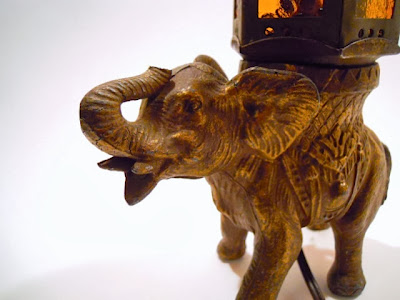I came across this wonderful little lamp by chance yesterday, while poking around in nearby Almonte with my friend Jennifer. Tucked away on the top shelf of the funky Tin Barn Market, it caught my eye as I was leaving. As I reached for it, three other women in the shop also saw it, one of whom looked a little put out that I'd seen it first. I felt a little guilty as I carted it off—although not guilty enough to give it up.
Its materials and design suggest to me that that it might be from the 1940s or 1950s, although it's always hard to tell with a design like this. I could see that it was made of spelter (a zinc alloy often used for decorative items), thinly plated to resemble brass or copper. It measures about 10 x 6 x 3 inches (25 x 15.25 x 7.5 cm), so it's bigger than a conventional nightlight, but smaller than a lamp.
The top appears to be made with copper-plated steel, and the inset glass panels are a lovely pebbled amber-orange glass. I found one on eBay that was almost identical, but with a finial that mine lacks, and frosted white glass panels. Mine also looks like it was dropped at some point, since the tip of the trunk was broken off, and part of the howdah on top was dented. The spelter is also showing signs of age with small cracks in the feet and head.
It needed a bit of cleaning up when I got it home, but it works, and I like it very much. Even better was the price. The one on eBay is listed at $500.00 US. I got mine for $65.00 CDN.
By the way, if you have a piece of plated spelter like this to clean, stick to gentle options. Soft cloths, a mild grease-cutting soap, rubbing alcohol, and minimal water are your best bets. Avoid metal cleaners and too much buffing, or you may remove the plating and end up with something that's more white metal than pseudo-brass or pseudo-bronze. If it's particularly gunky, like the howdah was on mine, a citrus-based cleaner like Citrasolv works nicely—just make sure to remove and neutralize the Citrasolv with alcohol or soap and water.
If anyone out there has seen one of of these, or knows more about it, I'd love to hear from you. And if you have one of your own and can send a photograph, that would be fantastic.
No idea where to put this little guy, but when something this fun comes along, who cares?
Elephant Lore the Day
In June of this year, a three-man team from Kenya arrived in Livingstone, Zambia to help control elephants with flashing lights.Kenyan wildlife experts discovered that, if small flashing lights were attached to trees or poles about 25 metres (82 feet) apart, elephants wouldn't venture beyond that point. And perhaps none too soon. In some places, elephants were venturing onto farmland so often that people had given up farming entirely, and resentment of elephants was growing.
The system actually originates in the United States, where lights have been used for years to keep wildlife from entering towns. The solar-powered lights are currently being employed in regions across East Africa, nailed to trees and electricity poles.
 |
| African elephant. Source: http://www.gorongosa.org/our-story/conservation/preventing- human-elephant-conflict |
To Support Elephant Welfare
Boon Lott's Elephant Sanctuary (Thailand)Wildlife SOS (India)
The Elephant Sanctuary (Tennessee)
David Shepherd Wildlife Foundation







Delightful Sheila as always. I love how you linked the lamp to your elephant lore of the day.
ReplyDeleteAww...thanks, Heather! You're very kind...
Delete